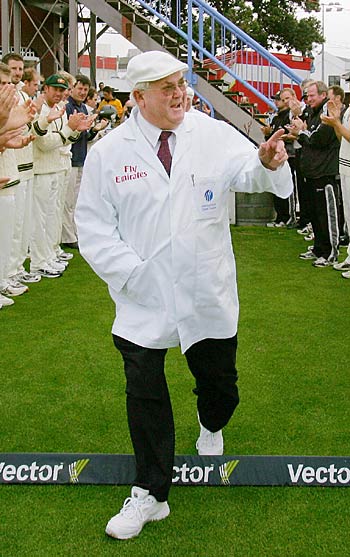This is interesting. Thanks to cricinfo.
The first ten-wicket haul in a Test innings
Way back in 1896, George Lohmann bagged nine wickets in the first innings against South Africa. For more than half a century no one could match that performance, until Jim Laker on a dusty pitch at Old Trafford in 1956. He snared 9 for 37 to skittle Australia out for 84 in the first innings, before delivering the perfect 10 in the second innings: 51.2-23-53-10, ensuring the Ashes remained with England. His figures of 19 for 90 remain unsurpassed even in first-class cricket.
The first Test hat-trick
This was a feat achieved when Test cricket was in its infancy, less than two years after the first match now recognised as a Test. Australian fast bowler Frederick “The Demon” Spofforth, one of the greatest bowlers of the 19th century, capitalised on a first-day pitch affected by a spell of rain shortly after the toss to take three in three in the one-off Test at the Melbourne Cricket Ground in 1879. His burst reduced England to 26 for 7, leaving their captain, Lord Harris, to regret the decision to bat first.
First to hit six sixes in an over
The game’s most versatile cricketer and its greatest allrounder, Garry Sobers was the first to bludgeon 36 in an over, when captaining Nottinghamshire in a county game against Glamorgan during the 1968 season. The hapless bowler was Malcolm Nash, a seamer who was trying out left-arm spin.
The first 100-mph delivery
The introduction of speed guns increased the obsession with discovering the world’s fastest bowler, and Shoaib Akhtar and Brett Lee kept the debate raging by passing the 150-kph mark with regularity. The winner was decided when Shoaib broke the 100-mph barrier, clocking 161 kmph (100.04 mph) in an ODI against New Zealand in Sharjah in 2002. Not without doubt, however. The speed gun used, a US-made “Stalker” radar gun, was one operated by a sponsor; the broadcaster’s own instrument for clocking speeds was out of order. Nevertheless, the fastest delivery on record till then, Jeff Thomson’s 99.8 mph steamer in 1975-76, had been trumped, much to Pakistan’s delight.

